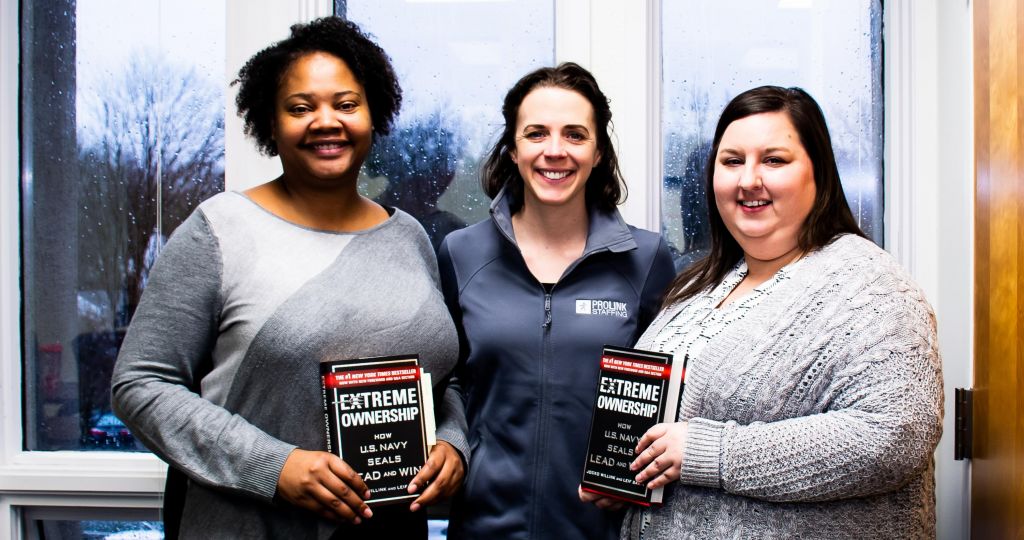The Prolink Book Club met earlier this year to discuss Extreme Ownership by Jocko Willink and Leif Babin. Throughout the discussion, we came to realize that Extreme Ownership and the key concepts that support it, while rigorous and challenging, are not extreme. Together, they provide a clear and practical road map for navigating the murky path that is effective leadership. More importantly, the learnings are accessible and applicable to anyone, in any role, in any business, provided they are seriously committed to making changes to their working styles. We have summarized key Extreme Ownership learnings in the following post and hope you, the reader, gain as much value as we did from reviewing them. Enjoy!
Extreme Ownership
The leader is responsible for everything that happens, success and failures. They must acknowledge mistakes and admit failures, take ownership for them, and develop a plan to win. When subordinates aren't doing what they should, leaders that exercise extreme ownership don't blame them. The leader bears full responsibility to enable the team to execute. A leader checks his or her ego and accepts blame for the team. They analyze what has happened to mitigate future errors.
The following paragraphs summarize the key concepts that define Extreme Ownership.
1. NO BAD TEAMS, ONLY BAD LEADERS
The concept that there are no bad teams, only bad leaders can be a difficult one to accept. Neverless, it is a concept that leaders must understand and implement to enable them to lead a high-performance team. Leaders must accept total responsibility, own problems that inhibit performance and develop solutions to those problems. Identifying weaknesses, leaders must seek to understand them and come up with solutions to overcome them.
2. BELIEVE
The leader must be on board with the vision or strategy that’s been passed down to them and be a champion for it even when they disagree. They must understand the why and believe so their team will follow. If the leader expresses doubt, their team will likely not adopt the idea or plan and will not execute it. A leader must believe in the greater cause. If they don’t believe, they won’t take the risks required to overcome challenges to win and they won’t get others buy in.
3. CHECK THE EGO
An attitude of humility and mutual respect forges elite teams. The ego clouds and disrupts everything - the planning process, the ability to take good advice, and the ability to accept constructive criticism. Often the most difficult ego to deal with is your own. When personal agendas become more important than the team, performance suffers and failure ensues. Check your ego!
4. COVER AND MOVE
Departments and groups within a team must break down silos. You must understand how others depend on you and how you can depend on other teams and departments. If you forsake this principle or work against each other, the results can be devastating to business and the overall team's performance.
5. SIMPLE
Simplifying as much as possible is crucial to success. When plans are too complicated people may not understand them. Everyone that is part of the mission must know or understand their role in the mission and what to do in the event things go wrong.
6. PRIORITIZE AND EXECUTE
The pressures on business leaders are intense. A leader must remain calm to make the best decisions possible under pressure. It's imperative that leaders determine the highest priority task, focus on that and execute. When priorities shift and change, communication of those changes up and down the chain is critical. Teams must recognize when the high priority item shifts to something else so that they can adjust and execute on it.
7. DECENTRALIZED COMMAND
Decentralized command allows leaders to operate effectively and further the strategic mission (whatever the mission or overall goal is). Decentralized command means that no one leaders can do it all. Instead, there must be leaders at every level empowered to make decisions, down to the front-line individuals on a team.
8. PLAN
Planning begins with identifying clear directives for the team. A broad mission results in lack of focus. To prevent this, the mission must be simplified. It must explain the overall purpose of the mission and front-line employees must understand the mission so they can execute on the plan.
9. LEADING UP AND DOWN THE CHAIN OF COMMAND
It is critical that Sr. Leaders show their teams how their roles are critical to company success. This is not intuitive for front line employees and is not simply understood as leaders may assume. Leaders must routinely communicate with their teams to help them understand their role in the overall mission.
If your team isn’t doing what you want them to do, you must first look at yourself. If they don’t understand the strategic mission, you must communicate it to them in terms that are simple, clear and concise so they understand.
10. DECISIVENESS AMID UNCERTAINTY
Leaders cannot be paralyzed by fear. That results in inaction. Waiting for the 100 percent right and certain solution leads to delay, indecision and an inability to execute. Leaders must be prepared to make an educated guess based on previous experience or knowledge. With markets at risk and ever changing, competitors actively working to overtake and outmaneuver opponents, professional careers and paychecks at stake, business leaders must be comfortable in the chaos and act decisively amid uncertainty.
DISCIPLINE EQUALS FREEDOM - THE DICHOTOMY OF LEADERSHIP
Every leader must walk a fine line. That's what makes leadership so challenging. Leadership requires finding the equilibrium in several qualities good leaders must possess. Here are a few examples of the dichotomy of leadership:
- Good leaders must be confident but not cocky
- Good leaders must be courageous but not foolhardy
- Good leaders must be competitive but a gracious loser
- Good leaders must be attentive to details but not obsessed by them
- Good leaders must be quiet but not silent
- Good leaders must be humble but not passive
- Good leaders must be calm but not robotic
- Good leaders must be close with their team, but not so close they forget who is in charge
- Good leaders must be aggressive but not overbearing
- Good leaders must execute Extreme Ownership, while exercising Decentralized Command
Leaders must act with professionalism and praise others for their successes. They must sustain excellent performance for the long run. Leaders must admit mistakes, failures and take ownership of them when it matters. They must not be afraid to speak up, and respectfully push back on things that could hinder mission success. By virtue of rank and position, the team knows who’s in charge. A leader must not glow or marvel at their position. It is a leader’s job to mitigate as much risk as possible without sacrificing the team. Team members should trust their leader will exercise good judgment, remain calm, and make the right decisions when it matters most.
Discipline equals freedom.
-- Ashley Simpson, HR Manager








